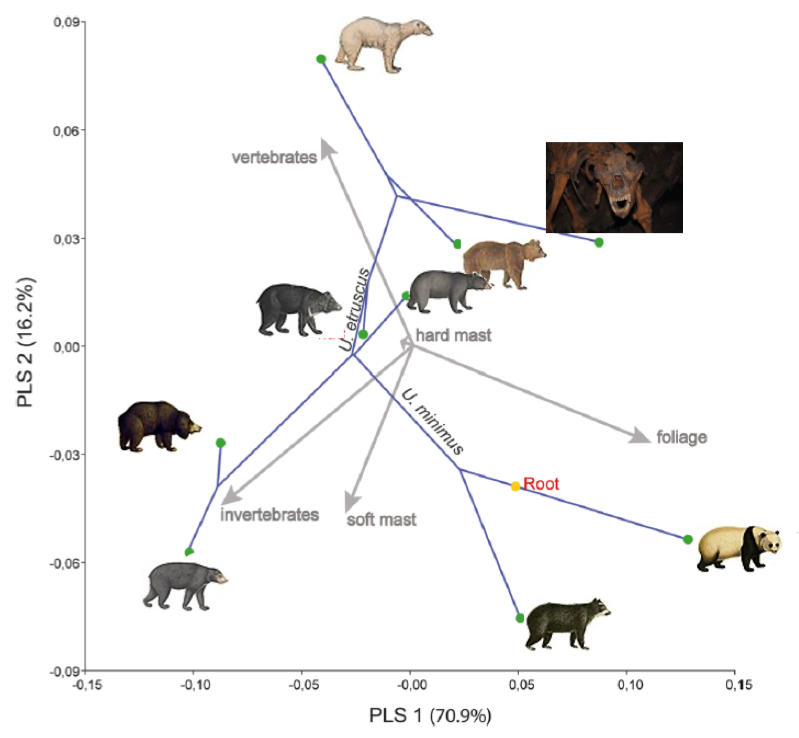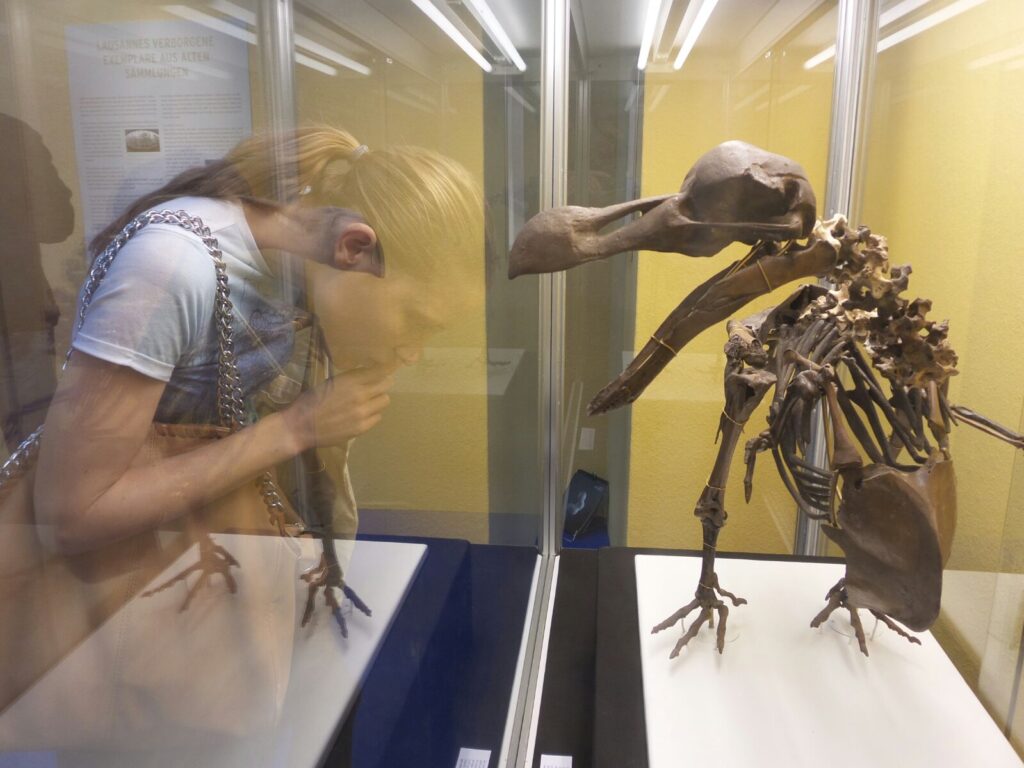Forschung
Sektion Mammalogie
Meine Forschungsinteressen konzentrieren sich auf die funktionelle Morphologie von Wirbeltieren und evolutionäre Anpassungen. Ich verwende hauptsächlich Paläophänomik in Form von geometrischer Morphometrie, um evolutionäre Anpassungen durch Zeit und Raum zu analysieren, sowie Knochenmikrostrukturanalysen und Finite-Elemente-Analysen. Im Folgenden werden einige wichtige Beispiele hervorgehoben.
Evolutionäre Anpassungen im Quartär
Angesichts der aktuellen Umweltveränderungen sind pleistozäne Tiere ein außergewöhnlich gutes Studiensystem. Eiszeitliche Ökosysteme erlebten an der Grenze zwischen Pleistozän und Holozän eine globale Erwärmung, und während einige Tiere sich anpassten, starben andere (lokal) aus. Darüber hinaus sind pleistozäne Tiere sehr eng mit rezenten Tieren verwandt, manchmal sogar derselben Art. Zu verstehen, wie und warum sich diese Tiere angepasst haben, ist von größter Bedeutung.

Als Modellart verwende ich unter anderem Bären. Im Pleistozän gab es in Europa zwei Bärentaxa: verschiedene Höhlenbären-Linien (Ursus spelaeus s.l.) und den Braunbären (Ursus arctos). Es ist zwingend erforderlich, dass wir verstehen, was dazu führte, dass die Höhlenbären im Zusammenhang mit der Klimaerwärmung am Ende des Pleistozän starben, während der Braunbär überlebte, um zu verhindern, dass die rezente Bärenarten dasselbe Schicksal erleiden. Bis vor kurzem waren Ernährung und Evolution des Höhlenbären weitgehend unbekannt. Ich habe Höhlenbären und ihre lebenden Verwandten mit Hilfe der Paläophänomik analysiert. Der Höhlenbär zeigt einen ähnlichen evolutionären Evolutionsverlauf durch den Morphospace wie der Panda (Ailuropoda melanoleuca), was auf ähnliche Anpassungen hinweist.
Evolution auf Inseln – das Labor der Natur
Manche Tiere sind mehr und andere weniger anfällig für morphologische Anpassungen, die durch Umweltveränderungen hervorgerufen werden. Zum Beispiel wurde gezeigt, dass Inseltiere während des Känozoikums viele und manchmal tiefgreifende morphologische Veränderungen in ihrer neuen Umgebung unterwurfen wurden. Die Evolution auf Inseln zu begreifen ist unerlässlich, um mögliche Veränderungen der tierischen Anpassungen in Bezug auf aktuelle Klimaänderungen zu verstehen. Nirgendwo sonst hat uns die Natur die Möglichkeit gegeben, evolutionäre Hypothesen in Bezug auf Anpassungen und funktionelle Morphologie in Duplo oder Triplo (was in einem Chemielabor die Norm wäre) zu testen, wodurch Inseln zu den einzigen Lebensräumen der Welt werden, in denen allgemeine und taxonspezifische Evolutionäre Anpassungen mithilfe der Paläophänomik unterschieden, quantifiziert und statistisch verifiziert werden können.
Ein interessantes Beispiel für Inselverzwergung ist Homo floresiensis. In meiner Forschung vergleiche ich H. floresiensis mit Inselverzwergte Säugetiere. H. floresiensis zeigt Anpassungen an eine Fortbewegung im niedrigen Gang. Darüber hinaus zeigt H. floresiensis eine archaische Handgelenksmorphologie und heterochrone Merkmale im Schädel und in den postkraniellen Überresten. Dies sind Merkmale, die vielen endemischen Inseltaxa gemeinsam haben.
Ein weiterer endemischer Hominine ist Homo luzonensis aus den Philippinen. Über diese Art ist nicht viel bekannt, aber sie waren klein wie H. floresiensis und zeigten eine Mischung aus archaischen und abgeleiteten Merkmalen. Unsere Forschung ist die erste, die Synchrotronstrahlungs-Röntgentomographie zur Analyse der Entwicklungsgeschwindigkeit in fossilien verwendet. Es hat sich gezeigt, dass H. luzonensis wahrscheinlich ein Entwicklungsmuster hatte, das dem modernen Menschenaffen ziemlich ähnlich war.

Der Dodo (Raphus cucullatus) ist vielleicht der rätselhafteste Vogel aller Zeiten. Ich bin Mitglied des Dodo-Forschungsprogramms und habe zu neuen Erkenntnissen über den Dodo und seine Umgebung beigetragen. Unter anderem habe ich das Gewicht des Dodos geschätzt basierend auf der größten jemals gemessenen Dodo-Femora-Probe. Die Ergebnisse zeigen, dass das Durchschnittsgewicht des Dodos etwa 12 kg betrug, was ungefähr fünfmal so schwer ist wie die größten lebenden Tauben, zu denen der Dodo gehört.
Der Haast-Adler (Hieraaetus (=Harpagornis) moorei) war der größte Adler, der je existiert hat und einst in Neuseeland lebte. DNA-Analysen haben gezeigt, dass sein nächster lebender Verwandter einer der kleinsten Adler der Welt ist, der Kaninchenadler (Hieraaetus morphnoides). Der Haast-Adler war mehr als eine Größenordnung schwerer als der kleine Adler und stellt ein außergewöhnliches Beispiel für eine schnelle Evolution innerhalb von weniger als 2 Millionen Jahren dar. Basierend auf geometrischer Morphometrie und Finite-Elemente-Analyse kamen wir zu dem Schluss, dass der Haast-Adler durch ein einzigartiges Mosaik aus adler- und geierähnlichen Merkmalen gekennzeichnet ist, das sich wahrscheinlich als Reaktion auf den äußerst anspruchsvollen Selektionsdruck entwickelt hat, routinemäßig besonders große Beute zu jagen und zu fressen.
Phänomik
Vorläufige Mikrostrukturanalysen von europäischen Eichhörnchen (Sciurus vulgaris fuscoater) Humeri aus Bayern, die in verschiedenen Jahreszeiten in einem kurzen Zeitraum von 10 Jahren zwischen 1907 und 1917 starben, wurden unter Verwendung eines weitgehend automatisierten Protokolls zur Datenerfassung analysiert. Die Analysen zeigten hochsignifikante Unterschiede im Knochenvolumen zwischen den Jahreszeiten, die stark auf intraindividuelle Veränderungen im Laufe der Zeit hindeuteten, die möglicherweise durch einen Mangel an Kalzium im Winterernährung verursacht wurden. Dies war der Wissenschaft bisher unbekannt. Dieses Projekt dient als Proof-of-Concept für die Paläophänomik, als potenter und vielseitiger Rahmen zur robusten Darstellung der Morphologie und zeigt das Potenzial von Big Data in der virtuellen Paläobiologie.


